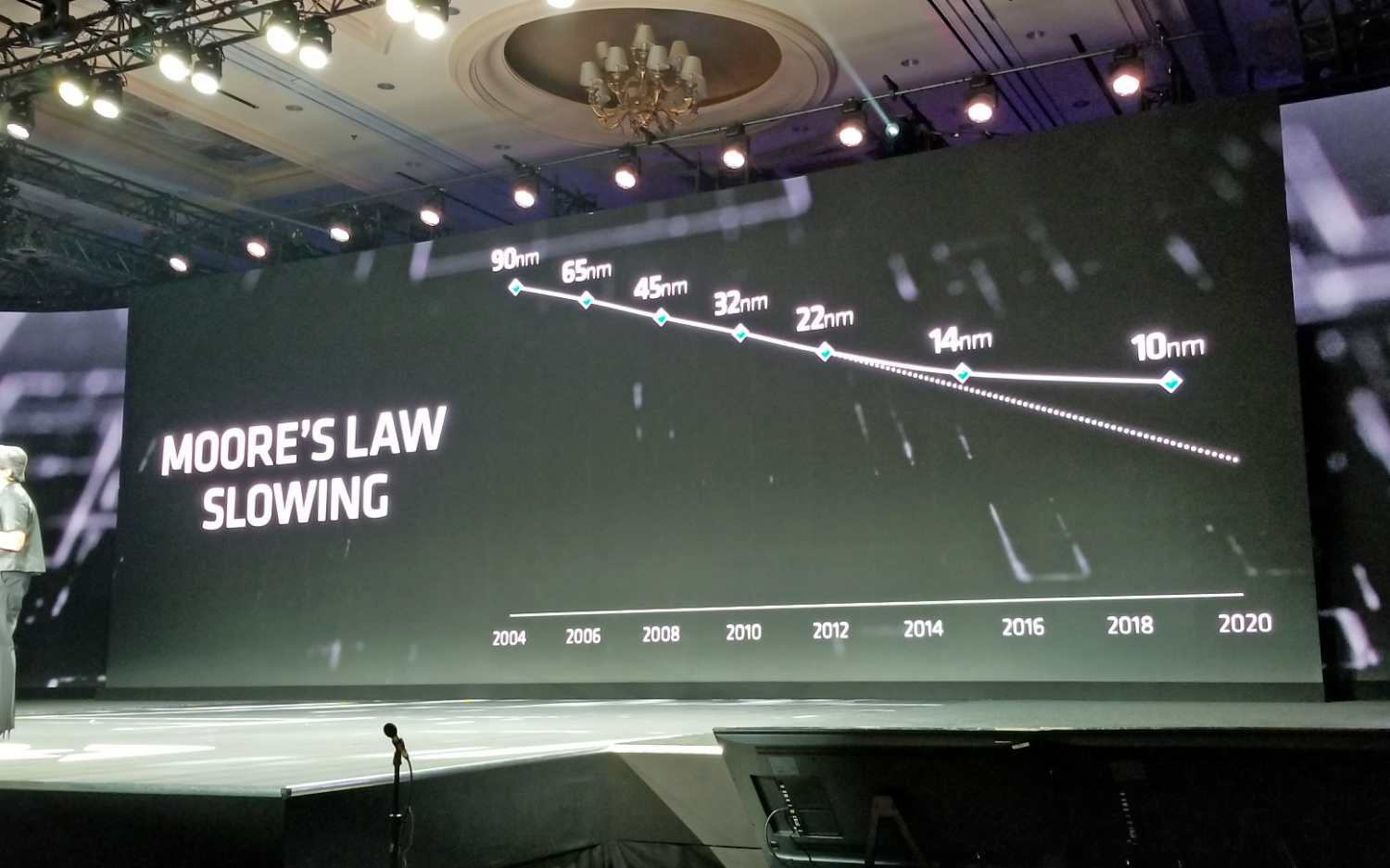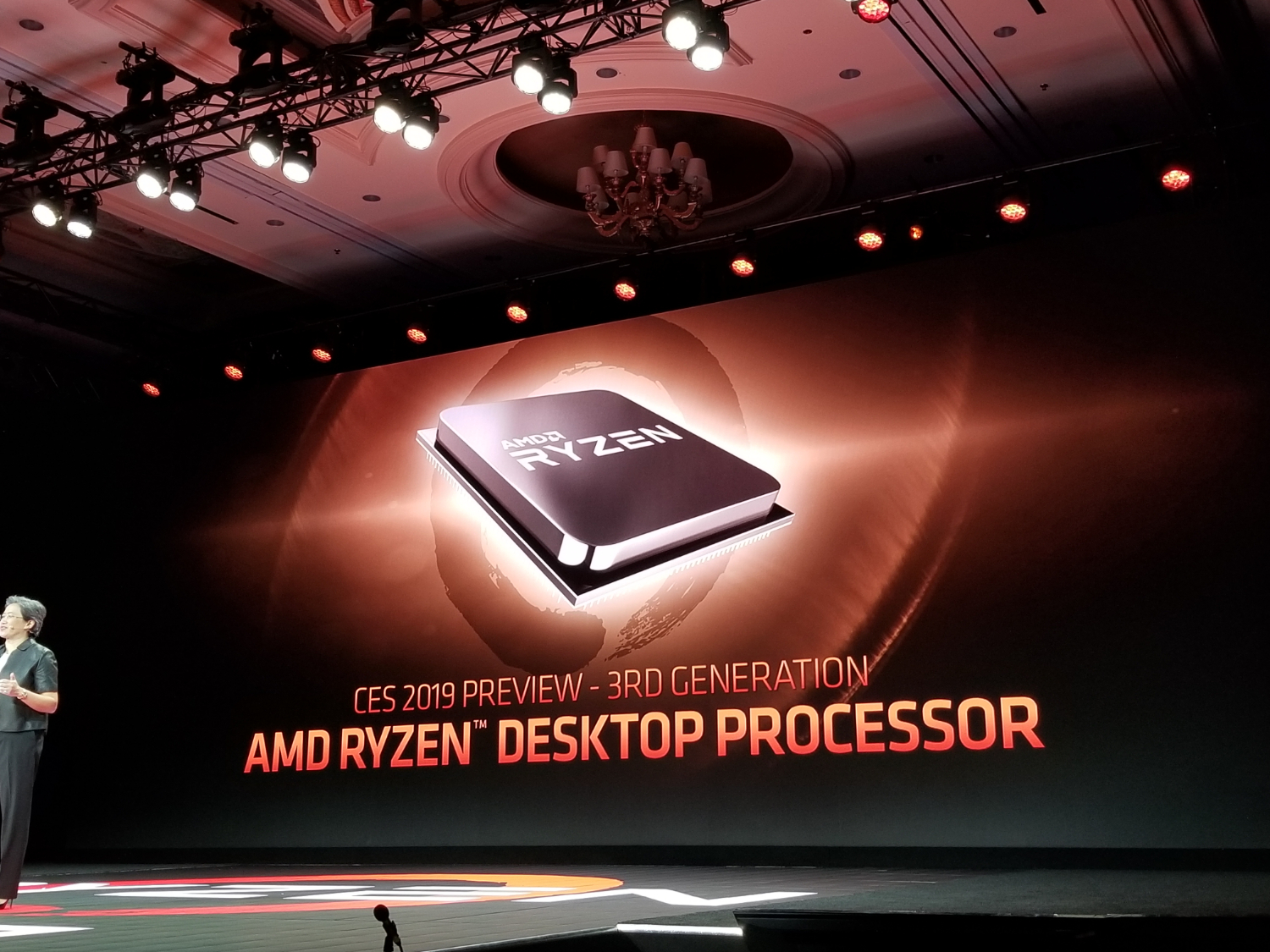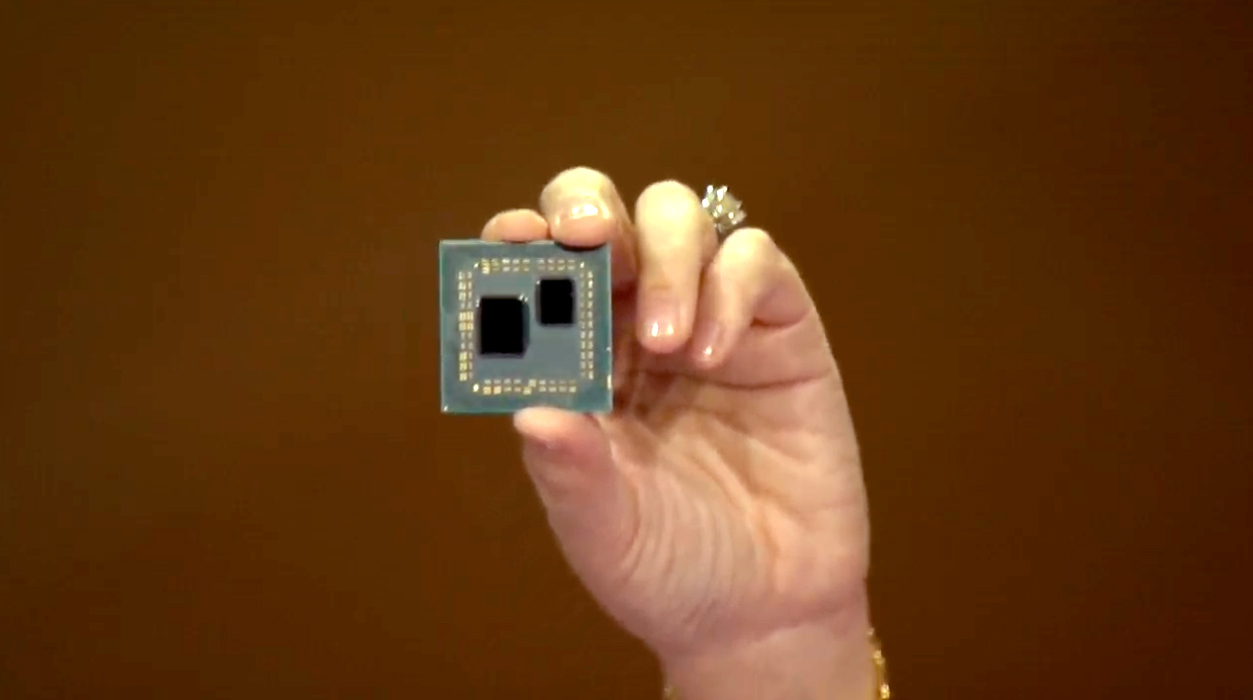AMD Demos Third-Gen Ryzen CPUs, Launches 7nm Radeon VII GPU
Today at CES, AMD CEO Lisa Su took the wraps off of the first consumer CPU and GPU to use the company's new 7nm process. During an hour and a half long presentation that included a look at its upcoming 7nm Epyc Rome data center chip, Su launched the new Radeon VII graphics card and showed an early demo of its upcoming third-gen Ryzen "Matisse" processor.
Due out February 7th for an MSRP of $699 (£550, $980 AU) in the U.S., the Radeon VII becomes team read's new flagship GPU for gaming. According to AMD, the new graphics card performs 25 to 42 percent faster in popular games than the Radeon Vega 64, its current performance leader.
Su also gave the world a sneak peek at its highly-anticipated third-gen Ryzen desktop CPUs, which are due out later this year. During a brief demo, she pitted the a pre-production third-gen Ryzen against a current Core i9. Both got similar scores in Cinebench R15, though AMD's chip used a lot less power.
Continue reading for the full details.
Opening Remarks
AMD CEO Lisa Su took to the stage and began by outlining AMD's progress over its 50 year history as it pushed the boundaries of high performance computing. AMD developed the first 1 GHz chip, the first Teraflop GPU, the first dual-core CPU, and was the first to combine graphics and CPUs together into a single package.
Su said the explosive growth of data over the last several years is driven by the exploding number of connected devices. That presents challenges that are being solved with sheer CPU and GPU horsepower. AMD feels that it will also take new innovations to handle the massive influx of data.
Moore's Law
Su explained that the pace of Moore's Law slowed over the last few years as moving to smaller transistors has become more expensive and time consuming. These slower transitions have found the industry falling behind the curve of Moore's Law, which necessitates several new advancements, such as smaller manufacturing nodes and new microarchitectures. It also requires new approaches that use several types of compute in heterogeneous systems.
Get Tom's Hardware's best news and in-depth reviews, straight to your inbox.
And that's where AMD says its Zen microarchitecture, the foundational underlying design of its Ryzen and Epyc processors, comes in. When AMD designed its new Zen architecture several years ago it made a bold decision to plow forward with a multi-chip design that relies on several small chiplets to form one large processor. This new approach allowed the company to realize several benefits from smaller chips, like higher yield rates and lower costs.
The best processor in 2017 came with 10 cores and cost $1,700 (£1,500, $2200 AU before tax). AMD knew that it could do better, so it created the Threadripper lineup for creative processionals. Su claims Threadripper is the #1 selling high-end desktop processor.
AMD's Notebook Business is Growing
According to Su, 160 million notebooks will be sold this year, with ultrathins being the fastest growing category. AMD wants to bring desktop-class performance to thin-and-light devices, but with long battery life.
Su also spoke about the Picasso Ridge processors that it announced several days ago. These new processors come with Zen+ cores paired with the Vega graphics architecture. Overall, the chips offer many of the same speedups we've seen from other second-gen Ryzen processors, albeit with a focus more on power efficiency for notebooks than the tuning for sheer compute power on the desktop.
She said that the second-gen processors offer up to 12% longer battery life. AMD also made its notable first steps into the Chromebook market.
After saying that more than 400 million gamers now game on AMD's graphics solutions and that the company expects that to grow by 50% 2021, Su invited the head of gaming at Microsoft, Phil Spencer up on stage.
Spencer reminisced the launch of the Xbox One. Spencer called out the fact that AMD helped it provide backward compatibility for games with the previous-gen systems. Spencer says that Microsoft is focused on developing content, community, and cloud services for gamers.
Radeon VII Launching February 7th
Su then announced the "next-generation of high-performance gaming GPUs," the Radeon Vega VII, the world's first 7nm gaming GPU. She held a card up in her hand to give the audience a first-hand glimpse.
This GPU comes as the gaming version of the Radeon Instinct MI60 that AMD announced last year, so it features many of the same benefits over previous-gen 12nm graphics cards. The Radeon VII packs 60 compute units and a tweaked Vega 20 architecture. Peak engine clocks weigh in at 1,800 MHz and offers 25% more performance than Vega 64 at the same power.
The Radeon VII is armed with 16GB of HBM2 memory that provides 1TB/s of memory bandwidth. We know that the MI60 offers up to 7.4 TFLOPS of FP64, 14.7 TFLOPS of FP32, and 29.5 TFLOPS of FP16 performance, but we'll have to wait for more details from AMD to see if the Vega VII matches that level of performance.
AMD designed the Radeon VII for gaming, so it faces Nvidia's 20-series that's designed to excel in raytraced titles. Relative to the previous-gen Radeon Vega 64 cards, AMD claims the card offers an average of 29% higher gaming performance, up to 29% more performance in Battlefield V, up to 40% more performance in games that use the Vulkan API, and 20-25% more performance in eSports titles. AMD also claims that card is, on average, 36% faster in content creation than the Vega 64.
AMD then demonstrated Devil May Cry 5 running at a 4K resolution. Su also talked about eSports and how faster GPUs help gamers improve their performance.
The Radeon Vega VII will be available February 7th. AMD will sell the card through third-party retailers as usual beginning on March 7, but the company will also sell the card directly, a new tactic for AMD, through its website beginning February 7. The card retails for approximately $699 (£550, $980 AU). For a limited time the GPU will come bundled with three games: Resident Evil 2, Devil May Cry 5, and Tom Clancy's The Division.
Su said that AMD has been working with Google to bring game streaming to life for AAA title through its Project Stream initiative. Google has chosen Radeon Pro graphics cards to run the workloads in its data centers.
Epyc Performance
Su then talked about the company's Epyc processors for the data center. The 7nm Epyc Rome server chips come bearing the Zen 2 microarchitecture and come with 64 physical cores, which equates to 128 threads per processor, double that of the first-gen Naples chips. In a two-socket server, that equates to 128 physical cores and 256 threads in a single box.
Rome is also the first PCIe 4.0 CPU, which offers double the bandwidth per channel. AMD has also made the processors backward compatible with its existing server ecosystem with the caveat that previous-generation motherboards only support PCIe 3.0. These drop-in replacements offer twice the performance of the previous generation per socket. You also get four times the floating point performance per chip.
On stage, she showed a live a demo of one 64-core Epyc processor against two of Intel's fastest data center processors. The single Epyc processor beat the two 28-core Intel Xeon 8180 processors in the scientific NAMD workload. The Epyc processor won by ~19%.
Third-Gen Ryzen is Coming
Su then showed off an "early" third-gen Ryzen desktop processor running a game paired with a Radeon VII. These 7nm chips will be the first desktop processors to support PCIe 4.0 right out of the box. That also implies that the new 500-series chipsets will also support the new standard.
The new Ryzen processors will come with the Zen 2 microarchitecture that provides a higher level of instructions per clock (IPC) than the first-gen Zen design, meaning the chips can process more cycles per clock. That will offer an additional speedup beyond the normal gains from increased clock frequencies.
AMD demoed a pre-production Ryzen 3000-series processor going head-to-head against a Core i9-9900K. It's noteworthy that AMD hasn't fully tweaked the design yet, meaning that it will likely extract more performance from the chip before it comes to market. The eight-core 16-thread Ryzen processor was about even with the eight-core 16-thread Core i9-9900K in a Cinebench multi-threaded workload, with the Ryzen score 2,057 to the i9's 2040.
Given that both processors have eight cores and sixteen threads, the benchmark results suggest that AMD is matching Intel's single-threaded performance, at least in this particular benchmark. Cinebench does respond well to AMD's SMT implementation, but the results are impressive nonetheless.
Possibly matching Intel's single-threaded performance is a watershed moment for AMD, as that type of workload has long been one of the few areas where the Ryzen processors lagged behind Intel's models. But that isn't all. Su also pointed out that the denser 7nm node allowed the Ryzen processor to consume less power, which ultimately equates to heat, than the Core i9-9900K.
The AMD processor pulled ~30% less power than the Core i9-9900K. That's a tremendous advantage over Intel's processors, which have gained a reputation for requiring high-end motherboards, power supplies, and coolers to extract the optimum level of performance. The Ryzen processors' impressive achievement means that it could be much cheaper to build full systems with AMD's Ryzen 3000-series processors, thus offering a similar level of performance while maintaining the value advantage.
Su held up a naked chip, showing that the third-gen Ryzen processors have two dies: one for compute and one for I/O. That's much like the design the company uses in its Epyc Rome processors.
Third-gen Ryzen is coming to market in the "middle of 2019," and Su said that the company would share more details as it comes closer to launch.
Su closed the show on a personal note, saying that she wants the industry to come together industry together to cross boundaries, and that together they can enable the impossible and allow the smartest and brightest minds to solve the most interesting and challenging problems.

Paul Alcorn is the Editor-in-Chief for Tom's Hardware US. He also writes news and reviews on CPUs, storage, and enterprise hardware.
-
jimmysmitty They need to correct Moores Law. It wasn't that the process nodes were getting smaller but that the number of transistors per square inch were doubling. Yes this does tend to correlate with process node shrinks but not always. It has slowed down though due to process node walls being hit and will probably not speed up but slow down more unless they can find an efficient way to stack transistors for CPUs or move beyond transistors and thus Moores law.Reply -
mtracy1991 Was the 3000 series for desktops talked about? I don't see anything so I am assuming no.Reply -
jimmysmitty Reply21660940 said:Was the 3000 series for desktops talked about? I don't see anything so I am assuming no.
Anandtech showed off a CPU shot of an 8 core with the IO Chip and some numbers showing it just under a 9900K in performance but not much was said about if the 8 core is the top end mainstream or if its just the start. -
mtracy1991 Reply21660981 said:21660940 said:Was the 3000 series for desktops talked about? I don't see anything so I am assuming no.
Anandtech showed off a CPU shot of an 8 core with the IO Chip and some numbers showing it just under a 9900K in performance but not much was said about if the 8 core is the top end mainstream or if its just the start.
I read some article and was stated that we wont see any 3000 series processors until middle of 2019
-
salgado18 Happy about Ryzen, cautious about Vega.Reply
They finally matched Intel's IPC, using less power, and on a modular design that is easy to escalate. Can Intel have an answer this year? Or will they need a new architecture to get back on top?
Happy Vega is fast, not so happy it is expensive. Cut half the memory and drop the price, we need strong competition against those RTXes. -
TCA_ChinChin Vega 7 is pretty much a disappointment but Ryzen 3000 shows a lot of promise by matching the i9-9900k core to core as an engineering sample.Reply -
shmoochie I just don't get why they would price match the 2080. They should be looking to undercut Nvidia, not go head-to-head.Reply -
InvalidError Reply
You can't increase transistor count without shrinks since the larger die you would otherwise end up with end up prohibitively expensive due to defect density and the number of die you can get per wafer. No process shrinks mean slow or no transistor budget increases because it isn't economically viable - can't double transistor budgets if the chip would end up costing more than twice as much due to being able to make less than half as many of those double-size chips per wafer.21660852 said:They need to correct Moores Law. It wasn't that the process nodes were getting smaller but that the number of transistors per square inch were doubling. Yes this does tend to correlate with process node shrinks but not always.
Every major increase in transistor count for a given product type and price point is directly linked to process shrinks.
















